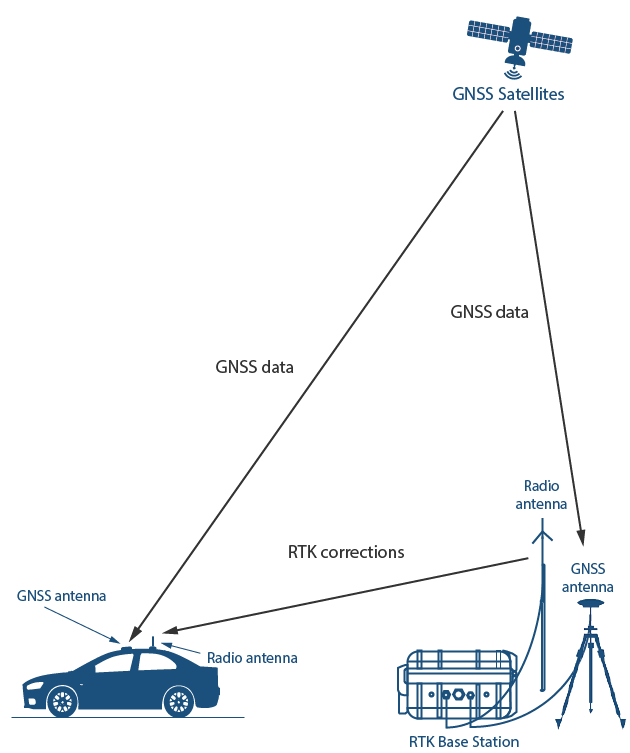RTK Solutions
NTRIP Modem
The VBOX NTRIP Modem allows you to receive RTK correction data via Internet, without having to operate your own RTK base station.
- Centimetre-level position accuracy
- Access public or commercial RTK Networks via the internet
- Wi-Fi access point for configuration via a simple HTML interface
- Integrated OLED screen for status and connection information
- No radio interference or limitation on communication range
RTK Base Station

The DGNSS RTK Base Station improves the positional accuracy of VBOX and other compatible GNSS systems by calculating and transmitting differential corrections.
- Centimetre-level position accuracy
- Range of up to 10 km with integral or mast mount radio transmitters
- RTCMv2, RTCMv3, CMR, RTCM v3.2 MSM4/7, or proprietary
- Store and recall up to 25 positions
- Up to 18 hrs battery life
RTK Positioning Correction Service
We offer flexible options to access the Topnet Live GNSS Positioning Correction Service within Europe with the purchase of any RTK enabled VBOX test solution.
How does an NTRIP Modem work?
The VBOX NTRIP Modem enables the roving VBOX unit, or any other RTK-enabled device, to send its position to the stations within the network – just as it would to a single VBOX Base Station. The NTRIP service provider will then calculate the appropriate corrections for the VBOX’s location based on the data from nearby reference stations. This correction information is then returned to the VBOX in the same RTCM format as is used for a single fixed base station.
In order to access NTRIP correction services, you have to register and subscribe to a cellular data plan with your local NTRIP provider, such as Topnet in the UK and Germany, Swepos in Sweden or Unavco in the USA.
NTRIP networks are growing in size and capability. Some networks are operated by the state, free of charge, while others are privately operated and can require a subscription fee.
It is also possible for RACELOGIC to guide you on creating your own NTRIP service (Base station and caster) at your proving ground, eliminating service provider costs and taking advantage of the increased range and reliability of transmission via the internet over 4G cellular or Wi-Fi.
One of the main advantages of NTRIP is that you can achieve centimetre accuracy without having to purchase and operate your own RTK base station.
By using the internet, you also overcome the transmission limitations posed by radios. Radio signals can be blocked by hills, buildings, trees, etc., and they have a limited distance they can travel.
Correction messages received via the RTK network can be an advantage if testing is conducted tens of kilometres away from the base station, over large changes in elevation or where topographical obstacles could get in the way.
If RTK coverage is available, the VBOX NTRIP Modem allows for vehicle testing that requires high positional accuracy – such as when validating critical safety systems like AEB/ACC - to be conducted where a VBOX Base Station cannot be deployed.

What is Network RTK?
Network RTK utilises one or more Continuous Operating Reference Stations (CORS) to provide RTK data to a GNSS rover, usually via mobile internet. The most common method of Network RTK involves a two-way communication link, which allows the roving vehicle to send its position to a service provider that is monitoring satellite observations from several reference stations around a country.
What is NTRIP?
NTRIP, short for Networked Transport of RTCM via Internet Protocol, is a protocol for streaming differential GPS data over the Internet in accordance with the specification published by RTCM. Most Network RTK systems are internet based and utilise this protocol. A constant internet connection is required to receive corrections, which can be done via a cellular modem, such as VBOX NTRIP, or a smartphone.
How does a Base Station work?
By utilising corrections from a fixed base station, the GPS engine can fix the position of the antenna very accurately. The technique involves the measurement of the carrier phase of the satellite signal, which is then subject to some sophisticated statistical methods to align the phase of these signals to eliminate the majority of normal GPS type errors.
This alignment process goes through three phases: acquisition, ambiguity ‘Float’ mode and ambiguity ‘Fixed’ mode. Accuracies in Float mode are in the region of 0.75-0.2 m and 0.01-0.02 m in fixed mode. The correction signal is normally sent out at intervals of 1 second, but can be increased if needed in order to reduce the required data rate.
The VBOX RTK Base Station can be used to improve the positional accuracy of VBOX GPS systems, by calculating and then transmitting differential correction data via radio to allow the roving GPS system to correct its position. Because a single base station can be used simultaneously by all the receivers in range, fixed based stations are ideal for proving grounds or test tracks, where you are testing in a confined area of up to 10 kilometres radius.

Subscribe now for news and offers
Speak to an expert
Contact us today to discuss your requirements.
One of our in-house experts will be in touch within 48 hours.